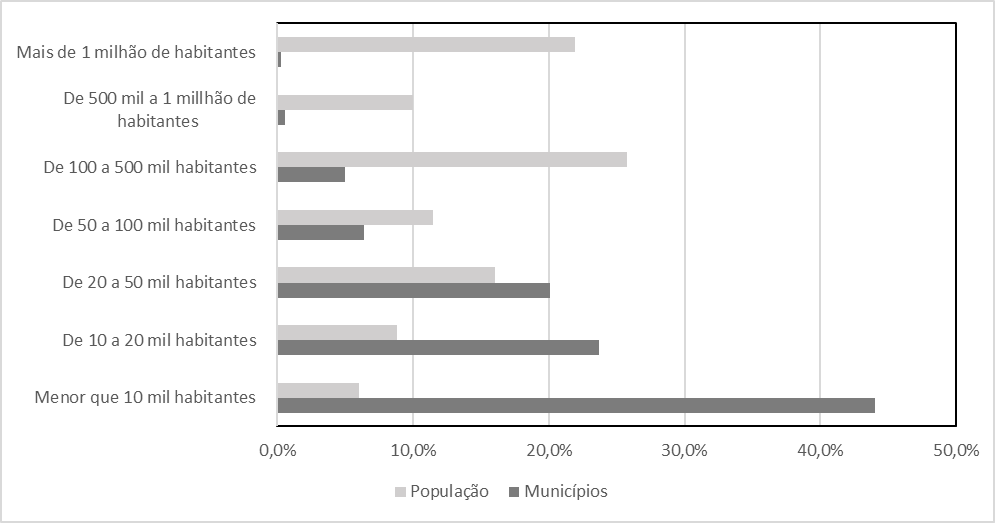IBGE releases population estimates of municipalities for 2021
August 27, 2021 09h00 AM | Last Updated: August 30, 2021 03h32 PM
The IBGE releases today the estimates for the resident population in the 5,570 Brazilian municipalities. On July 1, 2021, the Brazilian population reached 213.3 million inhabitants.
The municipality of São Paulo remained the most populous in Brazil, with 12.4 million inhabitants, followed by Rio de Janeiro (6.8 million), Brasília (3.1 million) and Salvador (2.9 million). The 17 Brazilian municipalities with a population above one million inhabitants concentrated 21.9% of the Brazilian population or 46.7 million persons.
In the last decade, the Population Estimates of the Municipalities pointed out a gradual increase in the number of large municipalities in Brazil. In the 2010 Census, only 38 municipalities had a population over 500 thousand inhabitants, and only 15 of them had more than one million residents. In 2021, the Brazilian municipalities with more than 500 thousand inhabitants add up to 49 and those with more than one million, to 17.
More than half of the Brazilian population (57.7% or 123.0 million inhabitants) was concentrated in only 5.8% of the Brazilian municipalities (326 municipalities with more than 100 thousand inhabitants).
Only 49 Brazilian municipalities with more than 500 thousand inhabitants concentrated nearly 1/3 of the Brazilian population (31.9% of the Brazilian population or 68 million inhabitants). Conversely, 3,770 municipalities (67.7%) with less than 20 thousand inhabitants concentrated 31.6 million inhabitants, which corresponded to only 14.8% of the population.

The population of the 27 capitals plus the Federal District surpassed 50 million inhabitants, representing 23.87% of the entire Brazilian population.
São Paulo remained as the most populous state, with 46.6 million inhabitants and concentrated 21.9% of the Brazilian population, followed by Minas Gerais, (21.4 million inhabitants) and Rio de Janeiro (17.5 million inhabitants). The five less populous states, which added up to nearly 5.8 million persons, were in the North Region: Roraima, Amapá, Acre, Tocantins and Rondônia.
The metropolitan area of São Paulo remained the most populous in Brazil, with 22.04 million inhabitants, followed by the metropolitan areas of Rio de Janeiro (13.19 million), Belo Horizonte (6.04 million) and the Development Integrated Region (RIDE) of the Federal District and Surroundings (4.75 million). Together, the 28 metropolitan areas, RIDEs and Urban Agglomerations with more than one million inhabitants have more than 100 million inhabitants, the equivalent to 47.7% of the Brazilian population. Among the major metropolitan areas and RIDEs, 20 of them have as seat a municipality of the capital, whereas eight of them have as seat municipalities of the interior of the states.
The municipal population estimates are one of the parameters used by the Brazilian Court of Audit to calculate the State and Municipal Revenue Sharing Fund, as well as it is a reference for a number of social, economic and demographic indicators. This annual release follows article 102 of Law no. 8,443/1992 and Complementary Law no. 143/2013.
The population of the municipalities was estimated by means of a mathematical procedure and results from the distribution of the population of the states, projected by demographic methods, among their municipalities. The method is based on the projection of the state population and on the growth trend of the municipalities, outlined by the municipal populations captured in the last two Population Censuses (2000 and 2010) and later adjusted. The municipal estimates also incorporated changes in the municipal territory limits occurred after 2010.
The effects of the Covid-19 pandemic on the population were not incorporated in this projection, due to the lack of new data on migration, as well as to the need to consolidate data on mortality and fertility, key to understand the demographic dynamics as a whole. The 2022 Population Census will bring not only an update of the population contingents, but will also subsidize future projections, key to understand the implications of the pandemic on the population in the short, medium and long term.
The table with the population estimated for each municipality was published today in the Official Gazette (DOU). The methodological note and the estimates of the population of the 5.570 Brazilian municipalities and of the 27 Federation Units can be seen on the right side of this page (in Portuguese).

